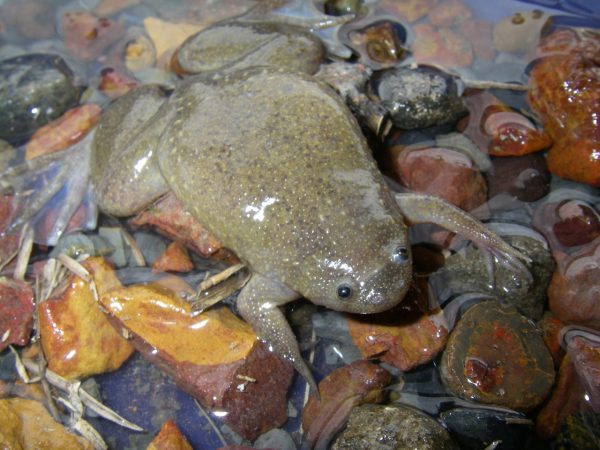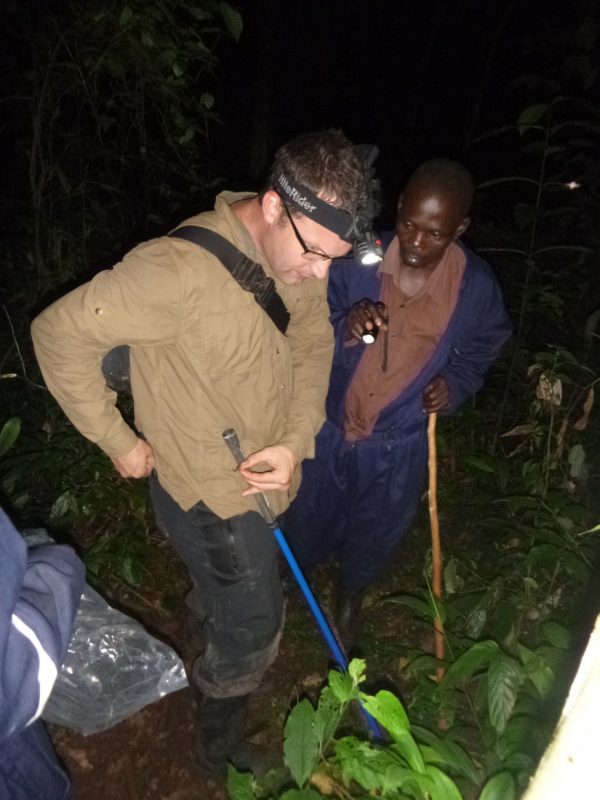
Photo courtesy of Bryan Stuart
Before modern-day pregnancy tests, doctors in the early 20th century resorted to unusual methods. One was to expose a live African clawed frog to a woman’s urine, then wait hours to see if it laid eggs. If it did, the test was positive.
The frogs were used in pregnancy tests until the 1970s when researchers developed easy-to-use, at-home tests. However, the legacy of the African clawed frog lives on, since its widespread use resulted in thousands of frogs being distributed from South Africa to labs and hospitals around the world.
Although African clawed frogs have been widely studied as a model for understanding the early development of eggs after fertilization, at least six species fooled researchers for more than a century with their nearly identical appearances.
The discovery of six new and one redescribed species increases the number of known African clawed frogs in the group from 22 to 29. Now researchers can begin asking questions about the genetic structure of the frogs, nearly all of which are the product of hybridization among ancestral species, and some that have up to six duplicated sets of DNA. The new species are described online in a December 2015 issue of the journal PLOS ONE.
Understanding the species’ genetic variations could improve conservation biology in biodiversity hot spots by helping better define those regions, said study co-author David Blackburn, Florida Museum of Natural History associate curator of herpetology.
“While we know a lot about African clawed frogs (genus Xenopus, pronounced “ZEN-o-pus”) from laboratory work, we know little about their evolution and diversity in the wild,” Blackburn said. “Different species often look very similar, but we found there are other pieces of evidence that show they are in fact different.
“A simple and important point is that we can’t conserve species without knowing where they occur and this work helps to determine the ranges of African clawed frogs.”
To distinguish the species, study researchers used new analytical techniques involving voice recordings, CT scans of internal anatomy, DNA and chromosome analysis and even documentation of different parasites among the frogs.
“The parasites can tell these things apart better than scientists can,” Blackburn said.
Researchers studying evolutionary genomics and hybridization are interested in African clawed frogs because within this single genus there are diploid, tetraploid, octoploid and dodecaploid species, meaning their genomes duplicate up to six times, as was the case for two of the new species.
“We really have no idea how prevalent hybridization is in the wild, in part because lab populations with associated genetic data are from very small geographic areas,” Blackburn said.

Photo courtesy of D.M. Portik
A model laboratory species as well as an invasive species in many places around the world, the African clawed frog, Xenopus laevis, is native to southern and central sub-Saharan Africa. But Blackburn said some of the species have a more restricted distribution, such as the Lake Oku clawed frog found in a single small lake on Mount Oku in Cameroon.
Lancelot Hogben, a scientist working in Cape Town, South Africa, discovered in 1930 a pregnant woman’s hormones found in urine could control the frog’s ovulation. Just a few years later, doctors in Europe and the U.S. were using the reliable “Hogben test” to detect the pregnancy hormone.
Hogben’s test was also important because it was possible for scientists to manipulate an animal’s reproductive cycle, which is how the animal got its start as a model species for scientific research. When the frogs were replaced by modern pregnancy tests, the amphibians either escaped or were released from labs and hospitals into the wild, allowing them to become invasive species in many areas of the world. Researchers have connected African clawed frogs with the spread of chytridiomycosis (pronounced ki-TREE-dee-o-my-CO-sis), a fungal disease that has proven lethal to many North American native frog species.
The frogs typically live in stagnant water, including ditches, cesspools and ponds, and are characterized by flattened bodies, vocal organs that produce sound underwater and claws on their first three toes.
To gain a better understand of their evolution, lead author Ben Evans and his research team will travel to Ghana next year to gather more genetic data and search for living populations that may represent one of the ancestral species before hybridization.
“For biodiversity conservation, it is paramount that we understand how much diversity there is and where it occurs,” said Evans, an associate professor of biology at McMaster University in Ontario, Canada. “This is particularly crucial in the tropics, where global biodiversity is highest and where species are particularly vulnerable to habitat alteration associated with climate change and human activities.”
Learn more about the Herpetology Collection at the Florida Museum.